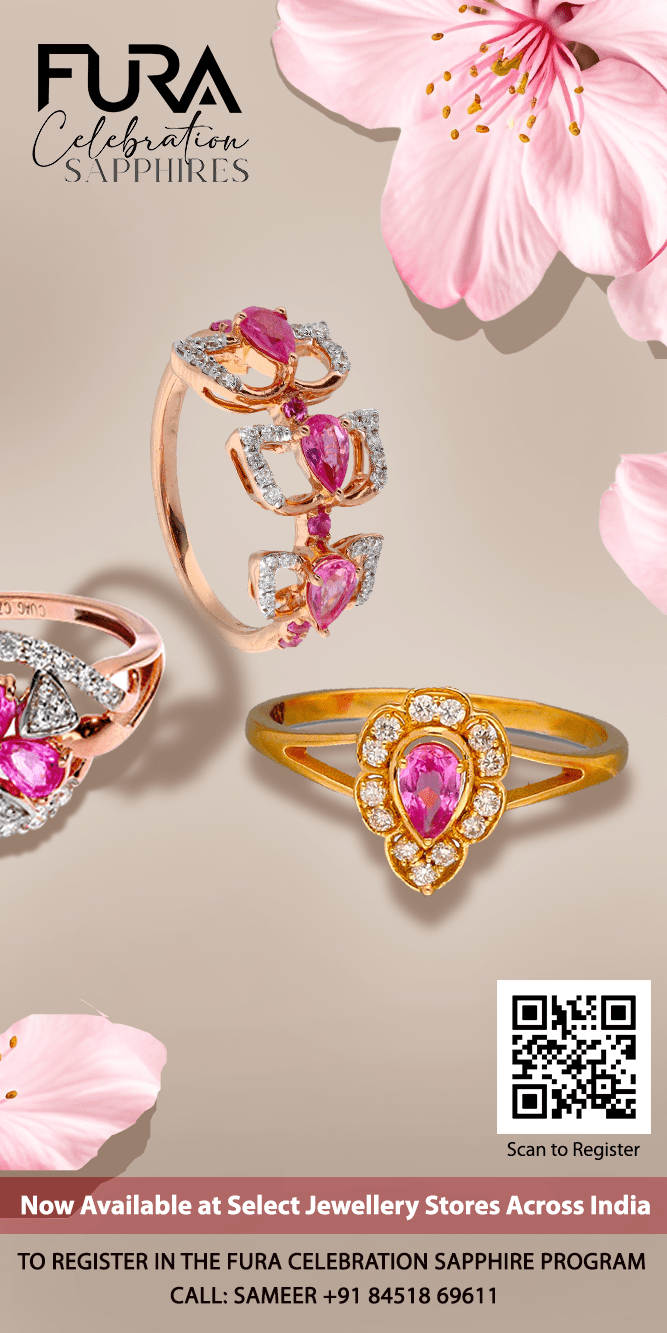RJ Market Watch
Importance of Kundan Jadau & Coloured Gemstone Jewellery in Millennials Life. How Retailers are attracting more customers for these categories ?
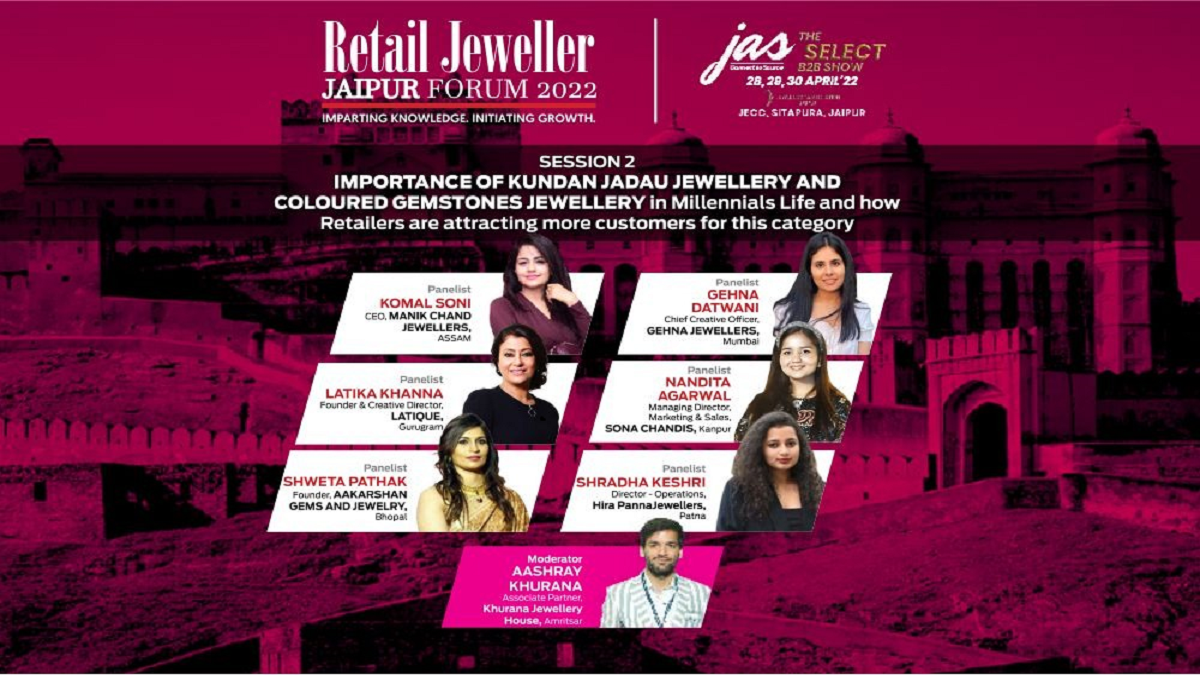
Retail Jeweller India Welcomes Komal Soni, CEO of Manik Chand Jewellers, Assam, Latika Khanna, Founder & Creative Director of Latique, Gurugram, Shweta Pathak Founder of Aakarshan Gems & Jewellery, Bhopal, GehnaDatwani, COO of Gehna Jewellers, Mumbai, Nandita Agarwal, Managing Director of Marketing & Sales, Sona Chandis, Kanpur, Shraddha Keshri, Director of Operations of Hira Panna Jewellers, Patna for this session that will be moderated by Ashray.Khanna – Director, Khurana Jewellery House, Amritsar
Ashray:
Kundan Polki jewellery has special significance in our country, this prized craft has been passed down for generations. The huge amount of labour and precision that goes into crafting each piece results in beautiful one of kind pieces. It would be really difficult to identify an Indian celebrity bride who didn’t wear polki for wedding celebrations. Sonam Kapoor wore polki for her mehendi, Priyanka Chopra for her haldi, and Anushka Sharma and Neha Dhupia wore polki on their wedding days as well. The centuries-old technique of handcrafting uncut diamonds into fine jewellery is a specialty of Bikaner, Rajasthan and it dates back to the Mughal era.
Today, these pieces are considered must-haves for brides. Another type of jewellery that is a must-have is colored gemstone jewellery, an option regarded as luxurious possessions, these unique items have a unique appeal to the simplest of outfits. The design of the pieces is usually decided on the basis of the usual shape of the gemstone. A needle is passed through the middle of the stone and the facets reflect light like a kaleidoscope. But these pieces are much more than what holds the eye, it is believed that all gemstones have natural healing power. Since ancient times, natural gemstones have been used in powdered forms in medicinal purposes, rubies strengthen the brain, heart, and liver, and emeralds promote love and friendship.
So ladies and gentlemen, let’s discuss the growing trends in these two categories, what has been influenced by the popularity and the millennials, and what we can do as an industry to take it to the next level. Let’s welcome the first speaker today, GehnaDatwani, COO of Gehna Jewellers, Mumbai. So the first question for you is, how can we use social media to skew the millennial mind more toward colored gemstones jewellery?
Gehna:
First things first, we need to rid ourselves of the notion that just because older generations have been coming to us, the younger generation will come, too just for that reason. Millennials are spending approximately 4 hours and 49 minutes of their day on social media, and they’re more likely to try new brands than ever before. This isn’t like previous times when men would visit the same tailors and barbers that their fathers or grandfathers did or women would buy the same make-up their mothers used to, they want to explore new things. They trust brands and online presence almost more than what the other generations have to say. They’re the actual influencers of the family, as mentioned earlier, they decide not only for themselves but for the rest of their family. So we have to use social media as much as we can. Using influencers, and campaigns can really be beneficial. The last point I’d like to add is that a lot of the younger generation really pride themselves in being socially and environmentally conscious. If they’re buying colored gemstones jewellery, they need to be reassured over and over again that everything from the mining process to the label, everything is being done ethically and sustainably.
Ashray:
Influencers are called influencers for a reason, they influence a generation actually and that leads to a happier economy. My second question to you is that jewellery connects the past, present, and future, and choosing between jewellery pieces and design, helps create a personal identity. What’s your take on that?
Gehna:
So, jewellery in India serves two main purposes. Firstly, it is an asset. People buy it because they know it’s going to compound in value but it’s also a work of art whenever an occasion calls them for wearing it. One thing that I noticed and loved, is that whenever someone comes to buy jewellery, they come with their mothers, grandmothers and when they’re trying it on, they’re imagining passing it on to their kin, although they’re the ones buying the jewellery and the decision is, of course, theirs, because it has to resonate with their identity, it isn’t just an individual decision, it is very cumulative, very family oriented and it has a lot of deeper significance than most other purchases they buy because it’s something that they believe connects them that to the generations after them.
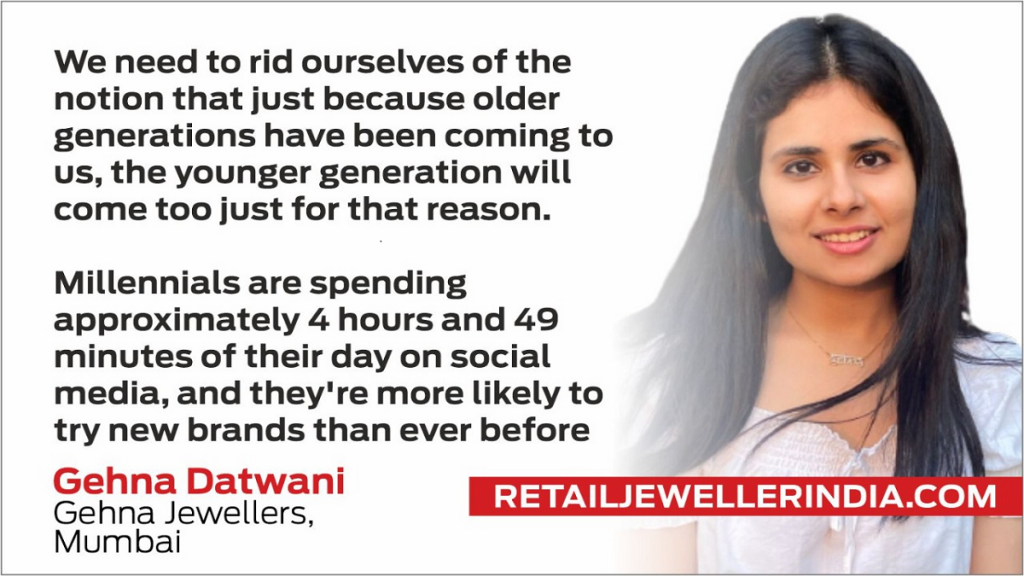
Ashray:
So jewellery is the thread that connects the past, present, and future. Moving on to the next speaker, Komal Soni who is the CEO of Manik Chand Jewelers, Assam. You come from East India, how are these two categories performing then?
Komal:
Basically I’m from Guwahati, Assam, which is the North-East of India and there I’d say, the taste of Kundan and Jadau polki jewellery is just catching up. People sometimes want to keep their own traditions, so on Assam’s side, people are still into their traditions. They’re now learning and changing their prefrences to Jadau jewellery. The demand has just started But also if we talk about East India, it has already started there. The market has already caught it. But in North East, it’s still a new thing.
Ashray:
I think with proper marketing and merchandising, we can get there because the population is ever-changing, and ever-evolving. And what is it that you’re doing to attract more clients for this category?
Komal:
For this category, as we all know India is mostly the youth population, and since our topic is about millennials who are confident, bold enough, and want to live life on their own terms, this is the category of people who want to invest but want to use it as well. Earlier it was mostly about investment when it came to heavy jewellery, but today’s generation wants utility along with the investment. They just don’t want to wear the heavy jewellery on their wedding day, but they want to be able to reuse it. Maybe the jewellery can be made multi-purpose, and detachable. They want multi-purpose utility, rings that turn into lockets, and much more. Secondly, it has to be, budget-friendly. We keep a full range of products as we know that Kundan Jadau Polki are all royal jewels and have only recently come into circulation among the common people. I think keeping all ranges is helpful so we can offer different options for the customers so whatever budget they have, they can find their perfect match. Millennials are also concerned with before, after service. We want service, the time I enter the showroom, maybe if I get a warm welcome, maybe I don’t want to buy but still, I’ll look at the collections and maybe I’ll buy something. Because the welcoming was warm. If I get a good facility and good service and we tell them how it is supposed to be taken care of, how it can be cleaned, and worn.
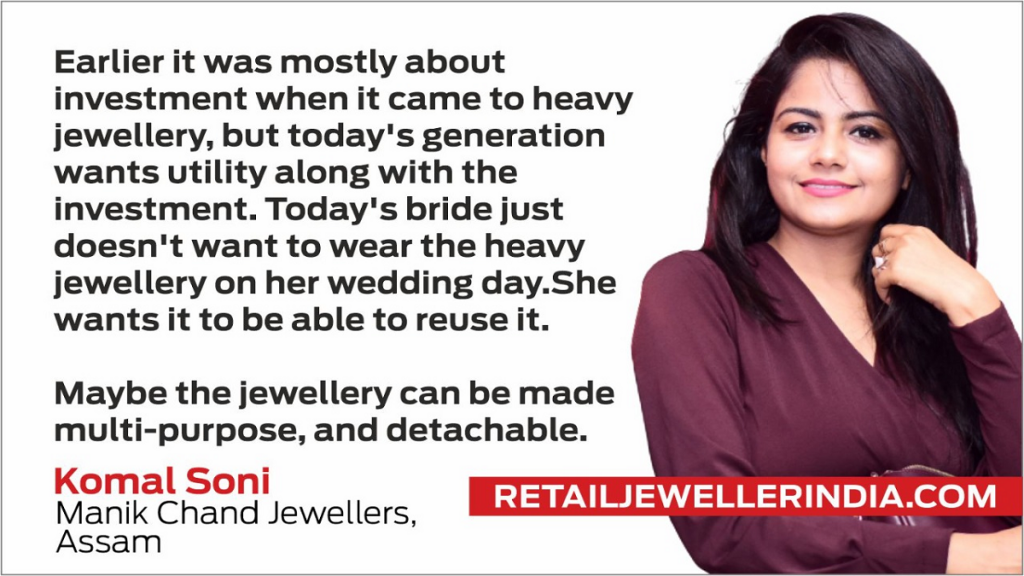
Ashray:
Very valid points, sometimes certain glitches in your products can be compensated with the kind of service you offer. Moving on, Miss Latika Khanna, Founder and Creative Director of Latique, Gurugram. My first question is, India’s leading designers like Sabyasachi and Manish Malhotra adorn big celebrities with Kundan Jadau polki jewellery and it’s begun a trend with these categories. What do you think needs to be done with the consumers to make them engage with these two categories?
Latika:
Thanks to designers like Sabyasachi and Manish, they’re adorning all the beautiful actresses in polki and colored gemstones. Heroines like Meena Kumari and all have worn polkis like nobody’s business, and if you think of Hollywood, even there Liz Taylor was the greatest proponent of fine jewellery. There’s actually a movie made, Breakfast at Tiffany’s after it. It’s not just Sabya and Manish who have done this, of course, they’re great at doing their jobs. As mentioned our greatest strength is the young population, I would really feel jewellery that we see and create is very high value and that becomes a very niche and aspirational kind of jewellery, and that becomes a little difficult for the younger generation to buy, and I feel beautiful, lovely young women who are working, for them to own a lovely diamond ring, it’s an amazing experience. I feel that as designers and retailers, we can design beautiful, everyday, wearable jewellery for the masses. Not for the elite or the 1% market, and in that if we can incorporate colored stones and polki. We can and should be designing everyday, wearable polki, and colored stone jewellery. Of course, social media is undoubtedly a powerful platform, where we all can put in, whatever we’re doing, designing, or retailing.
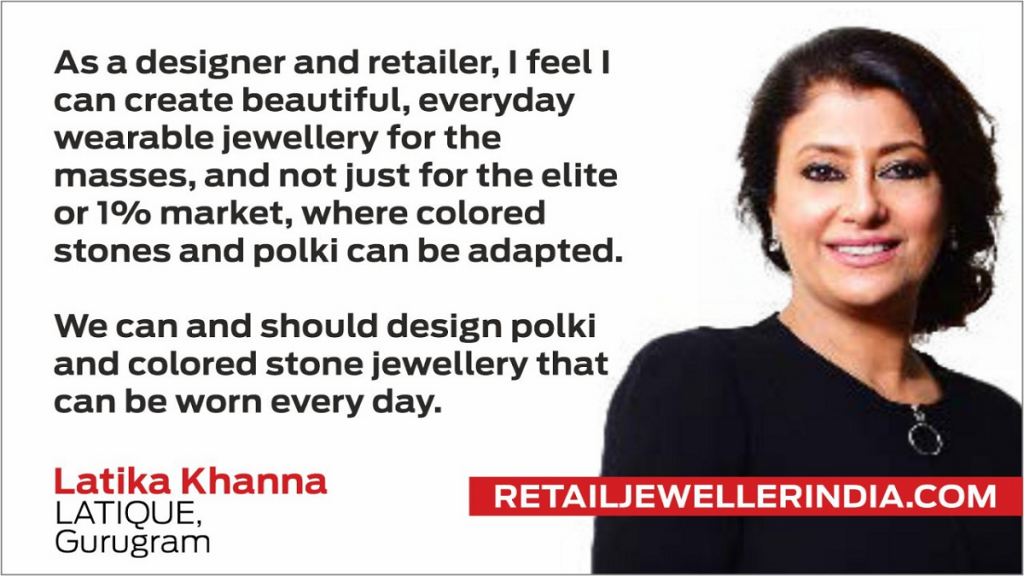
Ashray:
My next question for you is that as a leading jewellery designer, how do you perceive the future of these two categories?
Latika:
I’ve always loved these two categories. I think they’re the most beautiful gemstones. Mother Earth, I mean, what better? You have the rainbow and the whole array, and that’s one of our strengths. For us, it’s a great future with colored stone and polki jewellery for both categories.
Ashray:
People from the trade have done a great job capitalizing on the popularity of certain individuals, which has led to these categories blowing up. My next panelist is Nandita Agrawal, Managing Director, Marketing and Sales of Sona Chandis Jewellery, Kanpur. So the first question would be how much do uncut diamonds and colored gemstones contribute to the overall look of a bride?
Nandita:
I’m very passionate about personally styling my brides. If you want to incorporate gemstones in their outfit, you have to really understand her vibe of her, if she wants a romantic or subtle look, try incorporating emeralds in her look, polki and emeralds will make her more presentable. Even a lehenga tells a story about her. Gemstones are the best way to play with jewellery. Rubies are very understated gemstones in terms of polkis. I recently dressed a bride and she wore an ivory lehenga with rubies and it complimented her outfit. We need to make sure that the brides are happy and that we capture their tastes. Only sell them what they want, don’t push products that they don’t want. You have to spend time with them, making the experience more personal. If you want a bride to wear your gemstones, you have to first understand her vibe.
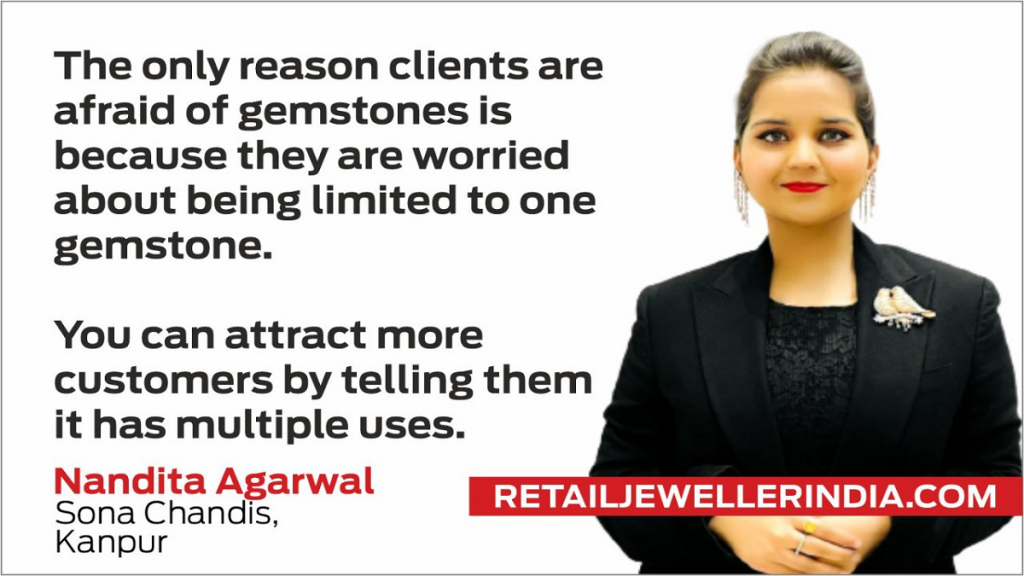
Ashray:
Very beautifully explained, the way you speak really shows the experience you may have gathered by styling many brides. So my next question to you is, one of the major concerns of our millennial clients is figuring out ways to make jewellery more wearable and it gets worn more often instead of sitting in the locker. What can we do to address this concern?
Nandita:
I’m the same actually. This bracelet I’m wearing can be converted into a detachable chain, so when I go for expensive pieces for my brides, I always ask them if I should make it detachable. If your ring is very heavy, you can wear it once a month but when you wear it as a pendant, you can make more usage out of products. If a choker is very heavy, go with detachable pieces, if you’re wearing detachable pieces, go with statement earrings, always go with a changeable gemstone concept. Your brides will appreciate it more. The only reason your customer is afraid of gemstones is that they’re worried about being constricted to one gemstone. Once you tell them you’ll find multiple uses to it, you will attract more customers
Ashray:
New concepts have been passing around and that has been the norm lately, so thank you for the answer. Next, we have Miss Shraddha Keshri, Director of Operations, Hira Panna Jewellers, Patna. Your first question is, our youth has been consistently influenced by the West in many spheres of life, what’s the most noteworthy influence you see among our Millennials with respect to jewellery?
Shraddha:
Millennials are heavily influenced by the West in all spheres of life, jewellery included. Color is the new companion of millennials. It’s not just gemstones, they want to use fashion jewellery to define the kind of person they are. They want to stand out, they want to be bold. A lot of semi-precious stones are also being used, like amethyst. Nowadays there are so many pieces made with 14 karat gold with these semi-precious stones, making it more affordable for the millennials. Another thing our industry needs to focus on is how to make gemstones for daily wear.
You need to have versatile options for wearing them, as well. There are also a lot of astrological signs attached to gemstones, especially in our culture. So a lot of these millennials get their readings done, and they decided to wear what their reading told them to, but the biggest problem is that they do not agree with designs that they think are basic and old-fashioned. They want something versatile. That’s one place where our jewellery industry needs to make a big change. Apart from the West, people are looking for everyday polki. There’s a customer base that doesn’t want to go for imitation jewellery because they want something they can use daily for a cheaper price. Because millennials are all working people, they want a very versatile design, so keeping all of this in mind, daily wear use of gemstones and polki is one of the biggest shifts in the industry right now.
Ashray:
One thing about influence from the West is that colored gemstones have opened up another avenue for us retailers. Second thing is, that advertising if done right can have a huge impact on sales. How can we advertise better to more effectively increase the jewellery appetite of Millennials?
Shraddha:
A lot of people don’t really understand the difference between marketing and advertising. Advertising is a part of marketing, while marketing is actually segmenting your audience and advertising according to them. Advertising to millennials is so different because they look for more than designs. My brand has a strong online presence, millennials appreciate brands that take a stand, be it environmental, or what you may and you have to show it to them. For example, a company that posts that we are with Ukraine will get more traction than a company that didn’t post anything. A company not talking about anything is bad in the millennial industry. This generation does not just believe in copying a piece. Customization has really increased.
They want to have a different and fresher outlook on the existing brands. For them, this is a part of who they are. 85% of millennials actually shop off videos, apart from having a strong online presence, you have to have interactive content. You can’t just expect people to buy your product if you just post a picture. You have talked about the product, you have to give them the story, and you have to give them why this will work for them. CSR, online presence, a lot of customization, and Millennials are loyal customers but the tough part is getting them to be loyal. The personal touch is very important.
Ashray:
Very insightful answer. Companies that haven’t talked about Ukraine will bring up very intelligent discussions among very intelligent people. Up next, we have Miss Shweta Pathak, CEO Akarshan Jewelers, Bhopal, ma’am what have been the most recent trend shifts in polkis in the jewellery market that you cater to?
Shweta:
Bhopal is a very experimental city to have a new taste. It has a very conventional, traditional Indian approach. For such people, buying jewellery at a specialty store is popular. Instead of a boutique and tell them that there are no discounts, charging hefty making charges. Being a first-generation jeweler, I got into working with gemstones, when I visited Jaipur, I thought of bringing more modularity into the jewellery. Something that can be worn in different ways. It’s like thinking of an occasion and that particular piece being used for that occasion, not just for keeping in lockers. I took a lot of my old jewellery and melt them down, and I had to show them to the customers, which in turn comes to me for Aakarshan, as my brand. Since I am now in the field, I’ve realized that jewellery is not about buyback. It is about legacy, something that I want to pass on to the next generation. Each one of us sitting here has different statements altogether and jewellery is representing who I am, and what exactly I want to put forward to the world. So jewellery speaks your language. It has to go beyond buybacks, it has to go as a collectible, a piece to treasure, something you deserve. So I believe in making jewellery that speaks this statement. I’m not making jewellery to create buybacks, I’m not flooding the market with bombast products. I’m creating, I’m making something very unique and beautiful.

Ashray:
Jewellery should be seen as more than just an asset, it should be looked at as something that is an expression. It’s an adornment.
Shweta:
People are often worried about losing their pieces of jewellery, we need to promote jewellery insurance in the industry. So there are a lot of initiatives that can be taken so we can promote more gold jewellery in the market.
Ashray:
Very rightly said. My next question for you is, in Rajmata Gayatri Devi’s autobiography she recalls her grandmother asking her never to wear Emeralds with a green saree but to wear them with a pink saree as they go really well with pink. Does your clientele have a preferred colored combination?
Shweta:
Green can go with green, green can go with pink, but even in polki, I’m bringing in the concept where we have changeable lines, where it can be changed to different coloreds but a single pendant. Pastels are in trend, morganite as well. We were never taught about this in school but it’s such a beautiful world to explore, and nobody tells us about it unless we get a call from destiny and we get to know about it. This is the knowledge that is lacking in the market. Every time I’m asked to customize, I incorporate my design as well. So if you’re a designer, incorporate your design. There are certain elements that cannot be copied like the ring Latika is wearing with a huge emerald on it, it cannot be copied.
Courtesy: Retail Jeweller India News

 Daily News4 weeks ago
Daily News4 weeks ago#LoveFromDad: De Beers unveils second ear-piercing drive to spur natural diamond demand among young consumers

 Exclusive3 weeks ago
Exclusive3 weeks agoUS tariff storm hits India’s gem & jewellery industry; faces major disruption threat, 1 million jobs at risk

 Wide Angle2 weeks ago
Wide Angle2 weeks agoTitan brings together Tanishq, Titan Watches and Titan Eye+ at first multi-brand store in the UAE

 Wide Angle1 month ago
Wide Angle1 month agoSaashri Jewellers ropes in actor Samantha Ruth Prabhu for grand opening of new store in Sydney
















